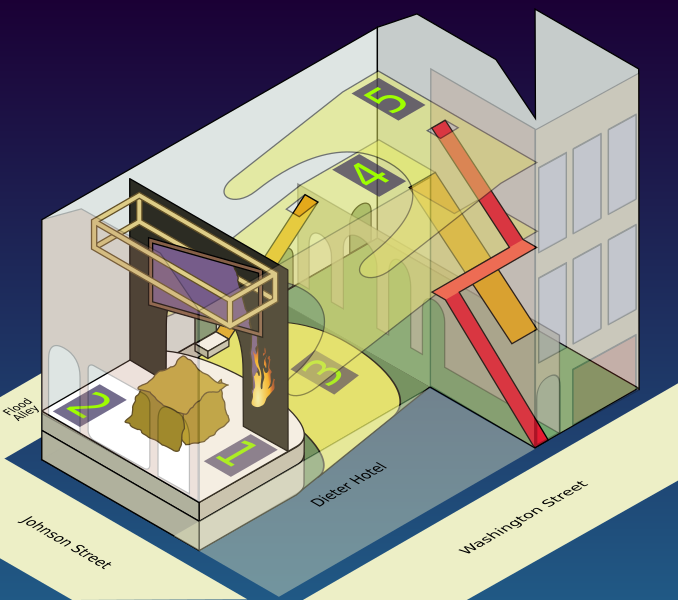Image: Brooklyn Theater Fire Schematic

Description: A schematic, not drawn to scale, of the Brooklyn Theatre, a building that stood at the corner of Johnson and Washington Street in the former city of Brooklyn NY from September, 1871 to December 5th, 1876 when it was destroyed by a catastrophic fire that claimed the lives of at least 278 persons, and probably nearer to three hundred. The diagram marks five key events: 1. Canvas hanging from a damaged border apparently comes in contact with a gas-lit border lamp, igniting it. This is noticed by the stage manager, J. W. Thorpe, and probably others. Water is not readily available; he directs stage hands to attempt to beat the flame out with stage poles. According to Fire Marshall Patrick Keany, in his December 18, 1876 report, the effort probably does more harm than good, as flaming debris knocks loose and spreads. 2. While the audience becomes restive, the actors continue with the play for at least a few more minutes. When it becomes clear that there is fire on the stage, they break character and at first ask the audience to remain seated: the fire would soon be out. The fire is rapidly gaining headway, however, and showers the actors with debris, undermining their efforts. The actors remain on stage, though fire is increasing around them, pleading with the audience not to rush or panic. They are largely ignored and a frantic panic commences. The actors soon flee the stage. Two actors attempt to retrieve street clothes from their dressing rooms but misgauge the fire's progress and are trapped; they perish. 3. Patrons in the front of the stage, the parquet and parquet circle, are able to leave the theatre in time; they have no stairs to negotiate and have two exits available to them; the two hundred and fifty people in this section of the theatre are out of the building within five minutes. 4. Patrons in the dress circle, the second floor balcony, have two means of exit, each serviced by single flights of stairs. The Flood Alley exit is locked, however, creating some confusion at that entrance. The main stairway out of the dress circle becomes jammed with people. Though the architect thought the stairs sufficiently wide to evacuate the balcony in under five minutes, the sheer mass of people attempting to negotiate the stairs at once cause patrons to jam up, trip, fall, and generally halt the flow of people down the stairs. Arriving police officers and firemen, with a few members of the theatre staff, do bring order to this stairway and the balcony is largely evacuated. 5. The family circle, or high gallery, is where the vast majority of fatalities occur. The gallery is only serviced by one stairway, consisting of three flights and one connecting corridor. This facility rapidly becomes jammed with people, but too far up to attract the attention of police or firemen who are, in any case, very much involved with the crush of patrons in the second floor balcony. Their 'window of opportunity' is also shorter, as hot smoke and fire, now travelling through the roof and ceiling of the theatre, impacts this region first. Before even half the gallery even reaches the stairs, dense, hot, blinding smoke arrives; most people succumb even as the evacuation in lower portion of the theatre is bought under control and patrons are finally evacuated. Neither police nor firemen are able to get into the gallery; they are driven away by dense smoke. Attempts to call up the stairs in the gallery get no response. This schematic is primarily intended to illustrate a sequence of events. It is not physically accurate, and distances should not be taken too literally. This schematic has been reconstructed from the period's Coroners report, report of the Fire Chief and Fire Marshall, and period reporting in the Brooklyn Daily Eagle and other papers of the day. It has not been vetted against the building's floor plan. I believe the relative positions of regions in the theatre are correct, based on period sources. Please see Brooklyn Theatre fire for more detailed information and references.
Title: Brooklyn Theater Fire Schematic
Credit: Own work
Author: Garry R. Osgood
Usage Terms: Creative Commons Attribution 3.0
License: CC BY 3.0
License Link: https://creativecommons.org/licenses/by/3.0
Attribution Required?: Yes
Image usage
The following page links to this image:

